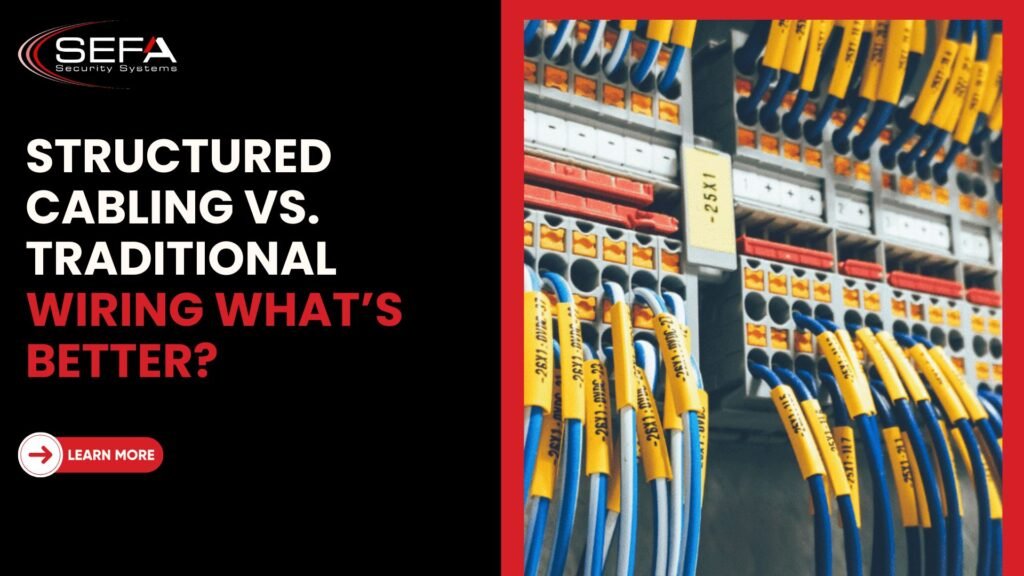
In today’s fast-moving world, good wiring is the backbone of every office and building. Many people do not know the difference between structured cabling and traditional wiring. If you plan to upgrade your office network or build a new one, this guide will help you understand which option is better for you.
What is Structured Cabling?
Structured cabling is a complete system of cables and hardware. It connects computers, phones, CCTV, and other devices in a building. It follows a clear plan and uses standard rules. This makes it easy to install, manage, and upgrade. Structured cabling uses different parts like patch panels, racks, switches, and outlets. The main idea is to keep all cables neat and organized. It does not create a mess of wires.
What is Traditional Wiring?
Traditional wiring is an old method. It connects each device with separate cables. Every time you add a new device, you need to run a new wire. This creates a mess. There is no clear plan, and wires can go in all directions. Traditional wiring does not follow modern standards. It works for small needs but becomes a problem when you have many devices or plan to expand.
Key Differences Between Structured Cabling and Traditional Wiring
Let’s look at the main differences. This will help you see why more businesses choose structured cabling.
1. Design and Planning
Structured cabling uses a planned design. Experts follow standards like TIA/EIA-568. They know where each cable goes. This makes it easy to find and fix problems.
Traditional wiring has no clear plan. Wires run wherever needed. If there is a problem, it is hard to find the bad wire.
2. Flexibility
Structured cabling gives more flexibility. You can add or remove devices easily. If your company grows, you just plug in new devices.
Traditional wiring is not flexible. Adding a new device means more work and more wires.
3. Looks and Cleanliness
Structured cabling looks neat. Wires go through cable trays and racks. They do not hang around. Your server room looks clean and safe.
Traditional wiring looks messy. Wires hang and get tangled. It does not look professional.
4. Cost and Time
Some people think structured cabling costs more. The truth is, it saves money in the long run. Installation costs may be higher at first, but you save on repairs and changes.
Traditional wiring may cost less to install but costs more later. Repairs take longer. Adding new devices needs more wires and more labor.
5. Performance
Structured cabling improves network performance. It uses high-quality cables like Cat6 or fiber optic. Data travels fast with fewer problems.
Traditional wiring uses mixed cables. This affects speed and performance. Old wires may not support modern devices.
6. Maintenance
Structured cabling is easy to maintain. Each cable is labeled. If a device stops working, you can fix it fast.
Traditional wiring is hard to maintain. Wires are not labeled. Finding a bad wire takes time.
Why Structured Cabling is the Best Choice
Now you see the big difference. Structured cabling is the best choice for offices, hotels, schools, hospitals, and big homes.
Here are the main reasons to choose structured cabling for your business:
Easy Upgrades: Technology changes fast. Structured cabling makes it easy to upgrade.
Better Safety: Neat cables reduce the risk of fire. There is less chance of someone tripping over loose wires.
High Performance: Your internet and phones work better. You get clear calls and fast downloads.
Future-Proof: Structured cabling supports new technologies. You do not need to change the whole system.
Good ROI: It saves money in the long term. Fewer problems mean fewer repair costs.
Where is Structured Cabling Used?
Many places use structured cabling:
- Offices: To connect computers, phones, and printers.
- Data Centers: For servers and storage.
- Hospitals: For medical devices and patient records.
- Hotels: For Wi-Fi, security cameras, and guest phones.
- Schools: For smart boards, internet, and CCTV.
Why Some Still Use Traditional Wiring
Some small shops or old buildings still use traditional wiring. They think it is cheaper. But when they grow, they face problems. Upgrading to structured cabling solves many hidden costs.
How to Switch to Structured Cabling
Switching is easy if you plan well. Here are some tips:
- Call a Professional: A good cabling company like SEFA Security can help you plan and install.
- Check Your Needs: How many devices do you have? Do you plan to expand?
- Choose Good Materials: Use good cables like Cat6 or fiber optic.
- Test Everything: After installation, test all points.
- Keep Records: Label all cables and keep a map.
Common Structured Cabling Mistakes
Avoid these mistakes to get the best results:
- Using poor quality cables.
- Not planning for future devices.
- Mixing old wires with new ones.
- Not labeling cables.
Always hire experts for the best results.
How Structured Cabling Supports Smart Buildings
Today, more buildings are smart. Smart lights, smart AC, and smart security need good cabling. Structured cabling is the backbone of smart tech. Good cabling helps you save energy. It connects sensors and controls. You can manage your building from one place.
How to Choose the Right Structured Cabling Company
Choosing the right company is very important. Here are some things to check:
- Experience: How many years in cabling?
- Reviews: What do other clients say?
- Price: Is the price fair?
- Support: Do they offer after-sales support?
- Warranty: Do they give a guarantee?
Why Now is the Best Time to Upgrade
Old wiring slows down your business. Customers hate slow internet. Employees waste time fixing bad connections. Upgrading now means better service and happy clients. Technology keeps changing. Do not wait for old wiring to break down. Invest in structured cabling today.
Conclusion
Structured cabling is the clear winner over traditional wiring. It is neat, safe, fast, and easy to manage. It costs less in the long run and keeps your business ready for the future. Do not wait. Call SEFA today for the best-structured cabling in the UAE. We make your network smart, safe, and strong.


